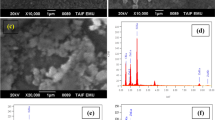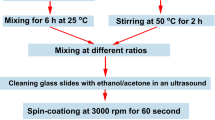Abstract
At present, inorganic semiconducting materials are the most economical and viable source for the renewable energy industry. The present work deals with the morphological and optical characterization of copper oxide (CuO) and zinc oxide (ZnO) thin films fabricated by layer by layer deposition on nickel oxide (NiO) coated indium tin oxide (ITO) glass by solution processing methods, mainly chemical bath deposition (CBD) and hydrothermal deposition (HTD) processes at room temperature. As a whole, the above inorganic composite materials (NiO/CuO/ZnO) can be applied in photovoltaic cells. An attempt has been made to study structural, morphological and absorption characteristics of NiO/CuO/ZnO heterojunction using state of the art techniques like X-ray diffraction (XRD), scanning electron microscopy (SEM), and UV spectroscopy. The energy band gaps of CuO and ZnO have also been calculated and discussed based on the UV spectroscopy measurements.
Similar content being viewed by others
References
Cai, G. F., Tu, J. P., Zhang, J., Mai, Y. J., Lu, Y., Gu, C. D., & Wang, X. L. (2012). An efficient route to a porous NiO/reduced graphene oxide hybrid film with highly improved electrochromic properties. Nanoscale, 4, 5724–5730. DOI: 10.1039/c2nr31397a.
Cao, L. Y., Park, J. S., Fan, P. Y., Clemens B., & Brongersma, M. L. (2010). Resonant germanium nanoantenna photodetectors. Nano Letters, 10, 1229–1233. DOI: 10.1021/nl9037278.
Chen, L. C., Huang, C. M., Gao, C. S., Wang, G. W., & Hsiao, M. C. (2011). A comparative study of the effects of In2O3 and SnO2 modification on the photocatalytic activity and characteristics of TiO2. Chemical Engineering Journal, 175, 49–55. DOI:10.1016/j.cej.2011.09.032.
Dandeneau, C. S., Jeon, Y. H., Shelton, C. T., Plant, T. K., Cann, D. P., & Gibbons, B. J. (2009). Thin film chemical sensors based on p-CuO/n-ZnO heterocontacts. Thin Solid Films, 517, 4448–4454. DOI:10.1016/j.tsf.2009.01.054.
Dar, M. A., Ahsanulhaq, Q., Kim, Y. S., Sohn, J. M., Kim, W. B., & Shin, H. S. (2009). Versatile synthesis of rectangular shaped nanobat-like CuO nanostructures by hydro-thermal method; structural properties and growth mechanism. Applied Surface Science, 255, 6279–6284. DOI:10.1016/j.apsusc.2009.02.002.
Dimopoulos, T., Peić, A., Müllner, P., Neuschitzer, M., Resel, R., Abermann, S., Postl, M., List, E. J. W., Yakunin, S., Heiss, W., & Brückl, H. (2013). Photovoltaic properties of thin film heterojunctions with cupric oxide absorber. Journal of Renewable and Sustainable Energy, 5, 011205. DOI: 10.1063/1.4791779.
Gan, Y., Gu, F. B., Han, D. M., Wang, Z. H., & Guo, G. S. (2010). Biomimetic synthesis of zinc oxide 3D architectures with gelatin as matrix. Journal of Nanomaterials, 2010, 289173. DOI:10.1155/2010/289173.
Ghosh, T., Dutta, M., Mridha, S., & Basak, D. (2009). Effect of Cu doping in the structural, electrical, optical, and optoelectronic properties of sol-gel ZnO thin films. Journal of the Electrochemical Society, 156(4), H285–H289. DOI: 10.1149/1.3079619.
Green, M. A. (2001). Third generation photovoltaics: Ultrahigh conversion efficiency at low cost. Progress in Photovoltaics: Research and Applications, 9, 123–135. DOI: 10.1002/pip.360.
Greene, L. E., Law, M., Tan, D. H., Montano, M., Goldberger, J., Somorjai, G., & Yang, P. D. (2005). General route to vertical ZnO nanowire arrays using textured ZnO seeds. Nano Letters, 5, 1231–1236. DOI: 10.1021/nl050788p.
Han, S. Y., Lee, D. H., Chang, Y. J., Ryu, S. O., Lee, T. J., & Chang, C. H. (2006). The growth mechanism of nickel oxide thin films by room-temperature chemical bath deposition. Journal of the Electrochemical Society, 153(6), C382–C386. DOI:10.1149/1.2186767.
Hochbaum, A. I., & Yang, P. D. (2010). Semiconductor nanowires for energy conversion. Chemical Reviews, 110, 527–546. DOI: 10.1021/cr900075v.
Herion, J., Niekisch, E. A., & Scharl, G. (1980). Investigation of metal oxide/cuprous oxide heterojunction solar cells. Solar Energy Materials, 4, 101–112. DOI: 10.1016/0165-1633(80)90022-2.
Hsueh, H. T., Chang, S. J., Weng, W. Y., & Hsu, C. L. (2011a). Fabrication and characterization of coaxial p-copper oxide/n-ZnO nanowire photodiodes. IEEE Transactions on Nanotechnology, 11, 127–133. DOI:10.1109/tnano.2011.2159620.
Hsueh, H. T., Hsueh, T. J., Chang, S. J., Hung, F. Y., Tsai, T. Y., Weng, W. Y., Hsu, C. L., & Dai, B. T. (2011b). CuO nanowire-based humidity sensors prepared on glass substrate. Sensors and Actuators B: Chemical, 156, 906–911. DOI:10.1016/j.snb.2011.03.004.
Izaki, M., Mizuno, K. T., Shinagawa, T., Inaba, M., & Tasaka, A. (2006). Photochemical construction of photovoltaic device composed of p-copper(I) oxide and n-zinc oxide. Journal of the Electrochemical Society, 153(9), C668–C672. DOI:10.1149/1.2218791.
Izaki, M., Shinagawa, T., Mizuno, K. T., Ida, Y., Inaba, M., & Tasaka, A. (2007). Electrochemically constructed p-Cu2O/n-ZnO heterojunction diode for photovoltaic device. Journal of Physics D: Applied Physics, 40, 3326–3329. DOI: 10.1088/0022-3727/40/11/010.
Kanmani, S. S., Ramachandran, K., & Umapathy, S. (2012). Eosin yellowish dye-sensitized ZnO nanostructure-based solar cells employing solid PEO redox couple electrolyte. International Journal of Photoenergy, 2012, 267824. DOI:10.1155/2012/267824.
Karthikeyan, B., Pandiyarajan, T., & Mangaiyarkarasi, K. (2011). Optical properties of sol-gel synthesized calcium doped ZnO nanostructures. Spectrochimica Acta: Molecular and Biomolecular Spectroscopy, 82, 97–101. DOI:10.1016/j.saa.2011.07.005.
Kidowaki, H., Oku, T., & Akiyama, T. (2012). Fabrication and evaluation of CuO/ZnO heterostructures for photoelectric conversion. International Journal of Research and Reviews in Applied Sciences, 13, 67–72.
Li, J. P., Sun, F. Q., Gu, K. Y., Wu, T. X., Zhai, W., Li, W. S., & Huang, S. F. (2011). Preparation of spindly CuO microparticles for photodegradation of dye pollutants under a halogen tungsten lamp. Applied Catalysis A: General, 406, 51–58. DOI:10.1016/j.apcata.2011.08.007.
Liu, H. L., Yang, J. H., Hua, Z., Zhang, Y. J., Yang, L. L., Xiao, L., & Xie, Z. (2010). The structure and magnetic properties of Cu-doped ZnO prepared by sol-gel method. Applied Surface Science, 256, 4162–4165. DOI:10.1016/j.apsusc.2010.01.118.
Mittiga, A., Salza, E., Sarto, F., Tucci, M., & Vasanthi, R. (2006). Heterojunction solar cell with 2% efficiency based on a Cu2O substrate. Applied Physics Letters, 88, 163502. DOI:10.1063/1.2194315.
Motoyoshi, R., Oku, T., Kidowaki, H., Suzuki, A., Kikuchi, K., Kikuchi, S., & Jeyadevan, B. (2010). Structure and photovoltaic activity of cupric oxide-based thin film solar cells. Journal of the Ceramic Society of Japan, 118, 1021–1023. DOI: 10.2109/jcersj2.118.1021.
Na, H. G., Kwak, D. S., & Kim, H. W. (2012). Structural, Raman, and photoluminescence properties of doubleshelled coaxial nanocables of In2O3 core with ZnO and AZO shells. Crystal Research and Technology, 47, 79–86. DOI:10.1002/crat.201100430.
Olsen, L. C., Bohara, R. C., & Urie, M. W. (1979). Explanation for low-efficiency Cu2O Schottky-barrier solar cells. Applied Physics Letters, 34, 47–49. DOI: 10.1063/1.90593.
Patil, U. M, Salunkhe, R. R, Gurav, K. V., & Lokhande, C. D. (2008). Chemically deposited nanocrystalline NiO thin films for supercapacitor application. Applied Surface Science, 255, 2603–2607. DOI:10.1016/j.apsusc.2008.07.192.
Pradhan, D., Sindhwani, S., & Leung, K. T. (2010). Parametric study on dimensional control of ZnO nanowalls and nanowires by electrochemical deposition. Nanoscale Research Letters, 5, 1727–1736. DOI: 10.1007/s11671-010-9702-2.
Pramanik, P., & Bhattacharya, S. (1990). A chemical method for the deposition of nickel oxide thin films. Journal of the Electrochemical Society, 137, 3869–3870. DOI: 10.1149/1.2086316.
Qin, H. W., Zhang, Z. L., Liu, X., Zhang, Y. J., & Hu, J. F. (2010). Room-temperature ferromagnetism in CuO sol-gel powders and films. Journal of Magnetism and Magnetic Materials, 322, 1994–1998. DOI:10.1016/j.jmmm.2010.01.021.
Umar, A., & Hahn, Y. B. (2006). ZnO nanosheet networks and hexagonal nanodiscs grown on silicon substrate: growth mechanism and structural and optical properties. Nanotechnology, 17, 2174–2180. DOI: 10.1088/0957-4484/17/9/016.
Vinodkumar, R., Letthy, K. J., Beena, D., Detty, A. P., Navas, I., Nayar, U. V., Mahadevan Pillai, V. P., Ganesan, V., & Reddy, V. R. (2010). Effect of ITO buffer layers on the structural, optical and electrical properties of ZnO multilayer thin films prepared by pulsed laser deposition technique. Solar Energy Materials and Solar Cells, 94, 68–74. DOI:10.1016/j.solmat.2009.02.017.
Wang, J. Z., Du, N., Zhang, H., Yu, J. X., & Yang, D. (2011a). Large-scale synthesis of SnO2 nanotube arrays as high-performance anode materials of Li-ion batteries. The Journal of Physical Chemistry C, 115, 11302–11305. DOI: 10.1021/jp203168p.
Wang, J. X., Sun, X. W., Yang, Y., Kyaw, K. K. A., Huang, X. Y., Yin, J. Z., Wei, J., & Demir, H. V. (2011b). Freestanding ZnO-CuO composite nanowire array films and their gas sensing properties. Nanotechnology, 22, 325704. DOI: 10.1088/0957-4484/22/32/325704.
Xia, X. H., Tu, J. P., Zhang, J., Wang, X. L., Zhang, W. K., & Huang, H. (2008). Morphology effect on the electrochromic and electrochemical performances of NiO thin films. Electrochimica Acta, 53, 5721–5724. DOI:10.1016/j.electacta.2008.03.047.
Xiang, J., Lu, W., Hu, Y. J., Wu, Y., Yan, H., & Lieber, C. M. (2006). Ge/Si nanowire heterostructures as highperformance field-effect transistors. Nature, 441, 489–493. DOI: 10.1038/nature04796.
Xu, Y. Y., Chen, D. R., & Jiao, X. L. (2005). Fabrication of CuO pricky microspheres with tunable size by a simple solution route. The Journal of Physical Chemistry B, 109, 13561–13566. DOI: 10.1021/jp051577b.
Yu, H. G., Yu, J. G., Liu, S. W., & Mann, S. (2007). Templatefree hydrothermal synthesis of CuO/Cu2O composite hollow microspheres. Chemistry of Materials, 19, 4327–4334. DOI: 10.1021/cm070386d.
Zainelabdin, A., Zaman, S., Amin, G., Nur, O., & Willander, M. (2010). Deposition of well-aligned ZnO nanorods at 50°C on metal, semiconducting polymer, and copper oxides substrates and their structural and optical properties. Crystal Growth & Design, 10, 3250–3256. DOI: 10.1021/cg100390x.
Zhang, Q. B., Zhang, K. L., Xu, D. G., Yang, G. C., Huang, Y. H., Nie, F. D., Liu, C. M., & Yang, S. H. (2014). CuO nanostructures: Synthesis, characterization, growth mechanisms, fundamental properties, and applications. Progress in Materials Science, 60, 208–337. DOI:10.1016/j.pmatsci.2013.09.003.
Zhou, X. F, Hu, Z. L., Fan, Y. Q., Chen, S., Ding, W. P., & Xu, N. P. (2008). Microspheric organization of multilayered ZnO nanosheets with hierarchically porous structures. The Journal of Physical Chemistry C, 112, 11722–11728. DOI: 10.1021/jp802619j.
Zou, C. W., Wang, J., Liang, F., Xie, W., Shao, L. X., & Fu, D. J. (2012). Large-area aligned CuO nanowires arrays: Synthesis, anomalous ferromagnetic and CO gas sensing properties. Current Applied Physics, 12, 1349–1354. DOI:10.1016/j.cap.2012.03.025.
Author information
Authors and Affiliations
Corresponding author
Rights and permissions
About this article
Cite this article
Joshi, S., Mudigere, M., Krishnamurthy, L. et al. Growth and morphological studies of NiO/CuO/ZnO based nanostructured thin films for photovoltaic applications. Chem. Pap. 68, 1584–1592 (2014). https://doi.org/10.2478/s11696-014-0596-9
Received:
Revised:
Accepted:
Published:
Issue Date:
DOI: https://doi.org/10.2478/s11696-014-0596-9




